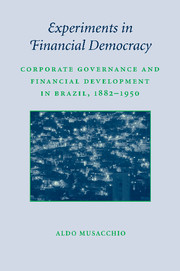 Experiments in Financial Democracy
Experiments in Financial Democracy Book contents
- Frontmatter
- Contents
- List of Figures and Tables
- Preface
- Acknowledgments
- 1 Introduction
- 2 Financial Development in Brazil in the Nineteenth Century
- 3 The Stock Exchange and the Early Industrialization of Brazil, 1882–1930
- 4 The Foundations of Financial Democracy: Disclosure Laws and Shareholder Protections in Corporate Bylaws
- 5 Voting Rights, Government Guarantees, and Ownership Concentration, 1890–1950
- 6 Directors, Corporate Governance, and Executive Compensation in Brazil, c. 1909
- 7 Bond Markets and Creditor Rights in Brazil, 1850–1945
- 8 Were Bankers Acting as Market Makers?
- 9 What Went Wrong after World War I?
- 10 The Rise of Concentrated Ownership in the Twentieth Century
- 11 Conclusion
- Bibliography
- Index
- STUDIES IN MACROECONOMIC HISTORY
10 - The Rise of Concentrated Ownership in the Twentieth Century
Published online by Cambridge University Press: 30 January 2010
- Frontmatter
- Contents
- List of Figures and Tables
- Preface
- Acknowledgments
- 1 Introduction
- 2 Financial Development in Brazil in the Nineteenth Century
- 3 The Stock Exchange and the Early Industrialization of Brazil, 1882–1930
- 4 The Foundations of Financial Democracy: Disclosure Laws and Shareholder Protections in Corporate Bylaws
- 5 Voting Rights, Government Guarantees, and Ownership Concentration, 1890–1950
- 6 Directors, Corporate Governance, and Executive Compensation in Brazil, c. 1909
- 7 Bond Markets and Creditor Rights in Brazil, 1850–1945
- 8 Were Bankers Acting as Market Makers?
- 9 What Went Wrong after World War I?
- 10 The Rise of Concentrated Ownership in the Twentieth Century
- 11 Conclusion
- Bibliography
- Index
- STUDIES IN MACROECONOMIC HISTORY
Summary
If Brazil started the twentieth century with a system of strong investor protections and relatively low ownership concentration, how is it that the corporate landscape in the second half of the century ended up being dominated by large conglomerates with concentrated ownership? This chapter explains the major changes effected in corporate governance and finance during the twentieth century.
The structure of corporate finance in Brazil changed radically after the 1930s and 1940s as banks supplanted the stock and bond markets as the main source of corporate finance. The government created a development bank that provided the bulk of long-term credit and commercial banks focused on short-term lending.
Ownership of large corporations ended up being highly concentrated because either families or the government seized full control of the voting equity (which became relatively easy to do subsequent to the introduction of nonvoting equity in 1932). Brazilian entrepreneurs ended up forming large, diversified conglomerates (grupos) with highly concentrated ownership for strategic reasons that have to do both with economics – they are helpful for overcoming many market failures – and politics – they are influential lobbying machines with sufficient clout to counter the powerful labor unions.
Finally, the government became the largest shareholder in the Brazilian economy, coming to control after World War I, and especially after World War II, the largest companies in the country by both bailing out existing companies (e.g., railways) and promoting the creation of state-owned enterprises (e.g., steel mills, mining companies, chemical plants, and banks).
- Type
- Chapter
- Information
- Experiments in Financial DemocracyCorporate Governance and Financial Development in Brazil, 1882–1950, pp. 236 - 252Publisher: Cambridge University PressPrint publication year: 2009


